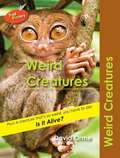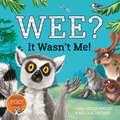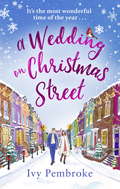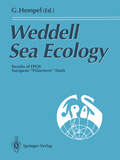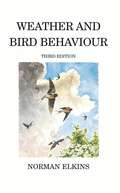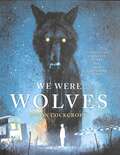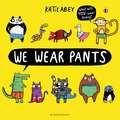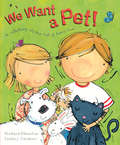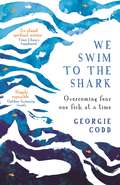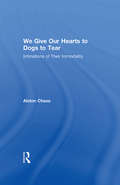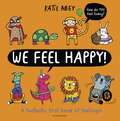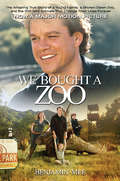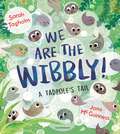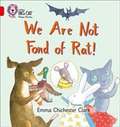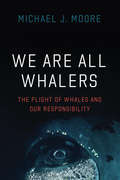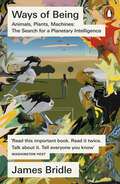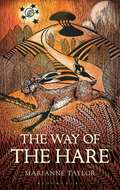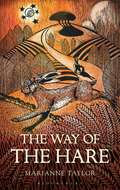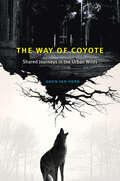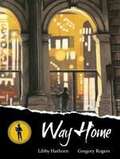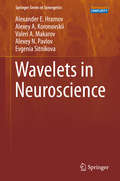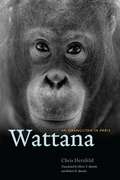- Table View
- List View
Weird Creatures (Trailblazers Ser.)
by David OrmeWhich octopus has floppy ears? How do you spot a see-through squid? Which creature stands without moving for sixty days? Outside. And in winter. Are you hungry? How about 3,000 ants for breakfast? And again for lunch. Welcome to the world of weird creatures. Get the facts. Got that? Then read a scary story about a creature that refuses to die: 'Is It Alive?
Wee? It Wasn't Me!: Winner of the Lollies Book Award! (Lenny Learns About . . . #5)
by Clare Helen WelshA funny story, all about wee, packed full of animal facts! The follow-up to the hilarious Poo! Is That You?Lenny the lemur is on holiday in Alaska. He's skipping across the snow, when he slips in a puddle. It's wet, yellow and smelly... WEE! But whose wee could it be? Lenny is on a quest to find out... Along the way, he meets various animals and learns all about their weeing habits! But the real question is: will he find that pesky puddle-piddler?Learn about caribou, turtles, wolves and more in the piddle-tastic Wee? It Wasn't Me! written by Clare Helen Welsh and illustrated by Nicola O'Byrne. Cleverly interweaving facts throughout, it also contains an information page at the back of the book, with a photo of each animal.
A Wedding on Christmas Street
by Ivy Pembroke'Heartwarmingly festive - if only all streets were like Christmas Street!' Ali McNamaraSam is about to propose to his girlfriend Libby, and his neighbours in Christmas Street all think they know the right way to do it. With their help - and sometimes hinderance - Sam gains a fiancée and the wedding planning begins. Meanwhile, Sam's nine-year-old son Teddy and his friend Pari - with their constant companion Jack the street dog - are fascinated by the arrival of a mysterious new neighbour on the street who has rented the empty, run-down house. Their attempts to spy on her are thwarted by her staying indoors with the curtains drawn most of the time. But soon Christmas Street begins to work its magic and Millie is reluctantly drawn into street activities.As Millie starts to relax into thinking she can have a different life, maybe even with Jasper, the local carpenter, someone turns up from her past to threaten that. But with all of the street looking out for her, Millie's Christmas will be filled with hope and promise.
Weather and Bird Behaviour (Poyser Monographs #56)
by Norman ElkinsThis classic Poyser title, now in its third revised edition, discusses in depth the various ways in which weather conditions influence bird behaviour. Weather conditions affect food and water availability, decisions about when and how to migrate, timing and success of reproduction, flight style, and physical comfort. Birds display many adaptations in form and behaviour that help them to cope with changing weather conditions, and this fascinating book uses a great variety of examples to explore the subject in depth. The text is enhanced throughout with evocative line drawings, there are many useful tables and figures, and there is also an 8pp colour photograph section.
Weather and Bird Behaviour (Poyser Monographs #40)
by Norman ElkinsThis classic Poyser title, now in its third revised edition, discusses in depth the various ways in which weather conditions influence bird behaviour. Weather conditions affect food and water availability, decisions about when and how to migrate, timing and success of reproduction, flight style, and physical comfort. Birds display many adaptations in form and behaviour that help them to cope with changing weather conditions, and this fascinating book uses a great variety of examples to explore the subject in depth. The text is enhanced throughout with evocative line drawings, there are many useful tables and figures, and there is also an 8pp colour photograph section.
We Were Wolves
by Jason CockcroftAn intense, darkly spellbinding story of a boy awaiting his father's return from prison as an ancient woodland awakes
We Wear Pants
by Katie AbeyPandas wearing pants? Surely not! And what about wombats wearing wellies, sloths in socks, or even giraffes wearing scarves? Whatever you do today...don't forget to get dressed! For any parent who has ever struggled to get their kids dressed - this hilarious book is for YOU! Parents and children will be giggling together as they find their favourite animals wearing funny things. We Wear Pants invites children to choose their favourite things across 12 spreads, packed with animals wearing pants, socks, pyjamas, glasses, shoes, shirts, wellies and more. With interactive speech bubbles and hilarious shout outs. Splashing around in puddles, driving buses and even riding on roller coasters - What will you wear today?
We Want a Pet!
by Richard Hamilton"We want a pet! We want a pet!" chant the kids."No! We will not let you have a pet. We are dead set against a pet!" say the parents.And so the battle lines are drawn -- can the kids convince the parents?As they lie in the grass watching bugs and beetles, watching little legs and eyes, watching ladybirds, spiders and flies, suddenly they realise these will be their pets!!Complete mayhem follows as the kids bring their gross, slimy, leggy, hairy 'pets' inside . . .
We Swim to the Shark: Overcoming fear one fish at a time
by Georgie CoddGeorgie Codd is scared of fish. Really, really scared. Even on dry land there's no escape: Georgie sees sharks in the dining room, squid tentacles in the street, has nightmares of being stranded at sea. Granny Codd understands. She has spent her life beside the water, but won't so much as paddle in it. Georgie's boyfriend is supportive, too, even when she decides that the answer to overcoming this fear lies in travelling to Thailand, learning to dive, and swimming with the biggest fish in the world: the massive, mighty whale shark. Could this immersive therapy actually work? There's only one way to find out. An anxious Georgie quits her job, leaves her life behind, and plunges into a realm of strange creatures, hidden depths, and intrepid diving adventurers. But as her quest expands across the oceans, her shark remains elusive, and everything else starts to fall apart around her.On this journey that veers towards death and destruction, Georgie must not only track down her shark, but find her way back to the surface.
We Give Our Hearts to Dogs to Tear: Intimations of Their Immortality
by Alston ChaseMore than a hauntingly beautiful memoir about small dogs in Big Sky country, this book is a wise account of the relationships among dogs, humans, and the land that surrounds them. It is the story of successive generations of Jack Russell terriers, their animal friends, and their human companions. Alston Chase searches for the immortality of dogs, what makes them unique companions, and why we humans willingly give them our hearts knowing that someday they will be broken. This book will resonate with anyone who has ever loved a dog.Chase muses that dogs are the embodiment of spirit over mortality and through the window of their brief lives we glimpse eternity. This eternal includes the Earth, the land, and the bonds forged between people and dogs over thousands of years. Chase sees threats in the decline of rural life, unbridled urbanization, and in dog breeders who judge by conformation to breed standards and fashion rather than ability and health.An uplifting tribute to the dogs we love, and a reflection on the limitations of life, this book shows a triumph of the spirit. Rich in poetic citations, it is an environmental cry for help, a naturalistic appreciation of a dissolving world, and a deeply spiritual reminder that nothing loved is ever lost.
We Give Our Hearts to Dogs to Tear: Intimations of Their Immortality
by Alston ChaseMore than a hauntingly beautiful memoir about small dogs in Big Sky country, this book is a wise account of the relationships among dogs, humans, and the land that surrounds them. It is the story of successive generations of Jack Russell terriers, their animal friends, and their human companions. Alston Chase searches for the immortality of dogs, what makes them unique companions, and why we humans willingly give them our hearts knowing that someday they will be broken. This book will resonate with anyone who has ever loved a dog.Chase muses that dogs are the embodiment of spirit over mortality and through the window of their brief lives we glimpse eternity. This eternal includes the Earth, the land, and the bonds forged between people and dogs over thousands of years. Chase sees threats in the decline of rural life, unbridled urbanization, and in dog breeders who judge by conformation to breed standards and fashion rather than ability and health.An uplifting tribute to the dogs we love, and a reflection on the limitations of life, this book shows a triumph of the spirit. Rich in poetic citations, it is an environmental cry for help, a naturalistic appreciation of a dissolving world, and a deeply spiritual reminder that nothing loved is ever lost.
We Feel Happy: A fantastic first book of feelings!
by Katie AbeyA fantastic first book of feelings that introduces little ones to a wide range of emotions. Why are the animals happy? What has made them feel sad? What do YOU feel excited about?We feel happy when reading our favourite book. We feel calm when we have a bath. We feel excited when we go to a party! We Feel Happy is the perfect book for starting a conversation about feelings with children. The animals are experiencing lots of different emotions, from the hippos who are excited to visit their friends to the shark who is grumpy about brushing its teeth.Includes learning hooks such as counting, first words and recognising animals, interactive speech bubbles, prompts and ideas on how to process and understand our emotions and lots of interesting things to spot on every page.______________________________________________________________________Vibrantly illustrated by the talented Katie Abey, illustrator of We Wear Pants, We Eat Bananas and We Catch the Bus and perfect for fans of You Choose and Just Imagine. We Feel Happy includes the feelings: happy, calm, worried, shy, curious, grumpy, sad, scared, sorry, excited and a guide written by early years specialist, Dr Helen Lewis, with lots of useful information for speaking to children about their emotions.
We Don't Eat This!: Independent Reading Green 5 (Reading Champion #4)
by Sue GravesThis story is part of Reading Champion, a series carefully linked to book bands to encourage independent reading skills, developed with Dr Sue Bodman and Glen Franklin of UCL Institute of Education (IOE)Ben and Jack really want to help on the farm, but the animals just do not like the food they're handing out!Reading Champion offers independent reading books for children to practise and reinforce their developing reading skills.Fantastic, original stories are accompanied by engaging artwork and a reading activity. Each book has been carefully graded so that it can be matched to a child's reading ability, encouraging reading for pleasure.
We Bought a Zoo: The Amazing True Story of a Young Family, a Broken Down Zoo, and the 200 Wild Animals that Changed T
by Benjamin MeeThe remarkable true story of a family who move into a rundown zoo-already a BBC documentary miniseries and excerpted in The Guardian.In the market for a house and an adventure, Benjamin Mee moved his family to an unlikely new home: a dilapidated zoo in the English countryside. Mee had a dream to refurbish the zoo and run it as a family business. His friends and colleagues thought he was crazy.But in 2006, Mee and his wife with their two children, his brother, and his 76-year-old mother moved into the Dartmoor Wildlife Park. Their extended family now included: Solomon, an African lion and scourge of the local golf course; Zak, the rickety Alpha wolf, a broadly benevolent dictator clinging to power; Ronnie, a Brazilian tapir, easily capable of killing a man, but hopelessly soppy; and Sovereign, a jaguar and would-be ninja, who has devised a long term escape plan and implemented it.Nothing was easy, given the family's lack of experience as zookeepers, and what follows is a magical exploration of the mysteries of the animal kingdom, the power of family, and the triumph of hope over tragedy. We Bought a Zoo is a profoundly moving portrait of an unforgettable family living in the most extraordinary circumstances.
We Are the Wibbly!
by Sarah TagholmThe funny, heartfelt and irresistible story of one small creature's epic journey from frogspawn to frog.OH MY CRIKEYS!Doesn't life move fast? One moment you're in the Wibbly, relaxing with your Wibbly friends. The next, they've all grown tails and turned into tadpoles! And what's more, they are bursting OUT of the Wibbly ... AND you've got to keep up! Some tadpoles don't feel ready to become frogs.And some never wanted to become tadpoles in the first place. This heartwarming, hilarious story speaks perfectly to the anxiety that children can feel about keeping up with those around them – perfect for fans of Oi Frog! and Tad by Benji Davies.
We Are Not Fond of Rat: Band 02b/Red B (PDF)
by Emma Chichester Clark Collins Big CatPoor Rat! No one wants to be his friend. But when the other animals see how sad he is, they all try to make him feel better. This gentle rhyming story is written and illustrated by Emma Chichester Clark.
We Are All Whalers: The Plight of Whales and Our Responsibility
by Michael J. MooreRelating his experiences caring for endangered whales, a veterinarian and marine scientist shows we can all share in the salvation of these imperiled animals. The image most of us have of whalers includes harpoons and intentional trauma. Yet eating commercially caught seafood leads to whales’ entanglement and slow death in rope and nets, and the global shipping routes that bring us readily available goods often lead to death by collision. We—all of us—are whalers, marine scientist and veterinarian Michael J. Moore contends. But we do not have to be. Drawing on over forty years of fieldwork with humpback, pilot, fin, and, in particular, North Atlantic right whales—a species whose population has declined more than 20 percent since 2017—Moore takes us with him as he performs whale necropsies on animals stranded on beaches, in his independent research alongside whalers using explosive harpoons, and as he tracks injured whales to deliver sedatives. The whales’ plight is a complex, confounding, and disturbing one. We learn of existing but poorly enforced conservation laws and of perennial (and often failed) efforts to balance the push for fisheries profit versus the protection of endangered species caught by accident. But despite these challenges, Moore’s tale is an optimistic one. He shows us how technologies for ropeless fishing and the acoustic tracking of whale migrations make a dramatic difference. And he looks ahead with hope as our growing understanding of these extraordinary creatures fuels an ever-stronger drive for change. For more information on Moore’s book and research, please visit his webpage at the Woods Hole Oceanographic Institution.
Ways of Being: Beyond Human Intelligence
by James Bridle'Iridescently original, deeply disorientating and yet somehow radically hopeful ... worth reading and rereading' Brian Eno'Be prepared to re-evaluate your relationship with the amazing life forms with whom we share the planet. Fascinating, innovative and thought provoking: I thoroughly recommend Ways of Being' Dr Jane Goodall, DBE, Founder of the Jane Goodall Institute and UN Messenger of Peace'Wonderful ... will make you feel and think the power of knowing how like all other lifeforms we are. There is nothing more important' Timothy Morton Recent years have seen rapid advances in 'artificial' intelligence, which increasingly appears to be something stranger than we ever imagined. At the same time, we are becoming more aware of the other intelligences which have been with us all along, unrecognized. These other beings are the animals, plants, and natural systems that surround us, and are slowly revealing their complexity and knowledge - just as the new technologies we've built are threatening to cause their extinction, and ours. In Ways of Being, writer and artist James Bridle considers the fascinating, uncanny and multiple ways of existing on earth. What can we learn from these other forms of intelligence and personhood, and how can we change our societies to live more equitably with one another and the non-human world? From Greek oracles to octopuses, forests to satellites, Bridle tells a radical new story about ecology, technology and intelligence. We must, they argue, expand our definition of these terms to build a meaningful and free relationship with the non-human, one based on solidarity and cognitive diversity. We have so much to learn, and many worlds to gain.'Brilliant ... Bridle shows the importance of listening to one another and our surroundings, and of creating new forms of community' Hans Ulrich Obrist
The Way of the Hare
by Marianne TaylorTo the people of rural Britain, hares are deeply beloved, perhaps above all other animals. They thrive in abundance in imagery but can be maddeningly elusive in reality. In our stories – ancient and modern – they are magical, uncanny and illogical beings which commune with the moon, vanish at will, and lose their minds when spring arrives. Yet despite the breadth and depth of its legends, the brown hare of the lowlands is a relative newcomer to our islands, and our 'real' ancient hare is the mountain hare of the most unforgiving high mountainsides.Hares of myth have godly powers, but real, earthbound hares walk a dangerous line – they are small animals with many predators but have no burrow or tunnel to shelter them from danger. They survive by a combination of two skills honed to unimaginable extremes – hiding in plain sight, and running faster than anything and anyone. The need to excel as hiders and runners ultimately directs every aspect of hare biology and behaviour, as well as inspiring our own wild ideas about hare-kind.This book explores hares as they are and as we imagine them, and the long and often bloody history of our association with these enigmatic animals. Elegant studies of molecular biology and biomechanical physics help us understand how hares are put together, while centuries of game estate records reveal how humans have commodified and exploited them. But it is ultimately the moments spent in the company of wild hares that allow us to bring together myth and reality to celebrate the magic of the living animal.
The Way of the Hare
by Ms Marianne TaylorTo the people of rural Britain, hares are deeply beloved, perhaps above all other animals. They thrive in abundance in imagery but can be maddeningly elusive in reality. In our stories – ancient and modern – they are magical, uncanny and illogical beings which commune with the moon, vanish at will, and lose their minds when spring arrives. Yet despite the breadth and depth of its legends, the brown hare of the lowlands is a relative newcomer to our islands, and our 'real' ancient hare is the mountain hare of the most unforgiving high mountainsides.Hares of myth have godly powers, but real, earthbound hares walk a dangerous line – they are small animals with many predators but have no burrow or tunnel to shelter them from danger. They survive by a combination of two skills honed to unimaginable extremes – hiding in plain sight, and running faster than anything and anyone. The need to excel as hiders and runners ultimately directs every aspect of hare biology and behaviour, as well as inspiring our own wild ideas about hare-kind.This book explores hares as they are and as we imagine them, and the long and often bloody history of our association with these enigmatic animals. Elegant studies of molecular biology and biomechanical physics help us understand how hares are put together, while centuries of game estate records reveal how humans have commodified and exploited them. But it is ultimately the moments spent in the company of wild hares that allow us to bring together myth and reality to celebrate the magic of the living animal.
The Way of Coyote: Shared Journeys in the Urban Wilds
by Gavin Van HornA hiking trail through majestic mountains. A raw, unpeopled wilderness stretching as far as the eye can see. These are the settings we associate with our most famous books about nature. But Gavin Van Horn isn’t most nature writers. He lives and works not in some perfectly remote cabin in the woods but in a city—a big city. And that city has offered him something even more valuable than solitude: a window onto the surprising attractiveness of cities to animals. What was once in his mind essentially a nature-free blank slate turns out to actually be a bustling place where millions of wild things roam. He came to realize that our own paths are crisscrossed by the tracks and flyways of endangered black-crowned night herons, Cooper’s hawks, brown bats, coyotes, opossums, white-tailed deer, and many others who thread their lives ably through our own. With The Way of Coyote, Gavin Van Horn reveals the stupendous diversity of species that can flourish in urban landscapes like Chicago. That isn’t to say city living is without its challenges. Chicago has been altered dramatically over a relatively short timespan—its soils covered by concrete, its wetlands drained and refilled, its river diverted and made to flow in the opposite direction. The stories in The Way of Coyote occasionally lament lost abundance, but they also point toward incredible adaptability and resilience, such as that displayed by beavers plying the waters of human-constructed canals or peregrine falcons raising their young atop towering skyscrapers. Van Horn populates his stories with a remarkable range of urban wildlife and probes the philosophical and religious dimensions of what it means to coexist, drawing frequently from the wisdom of three unconventional guides—wildlife ecologist Aldo Leopold, Taoist philosopher Lao Tzu, and the North American trickster figure Coyote. Ultimately, Van Horn sees vast potential for a more vibrant collective of ecological citizens as we take our cues from landscapes past and present. Part urban nature travelogue, part philosophical reflection on the role wildlife can play in waking us to a shared sense of place and fate, The Way of Coyote is a deeply personal journey that questions how we might best reconcile our own needs with the needs of other creatures in our shared urban habitats.
Way Home
by Libby Hathorn Gregory RogersIt's night and the dark is filled with strange sounds as Shane makes his way home. On a fence he finds a stray cat that at first growls and spits at him. But Shane talks and strokes the kitten to calmness, and decides to take the 'Spitfire, Kitten Number One,' home with him. No gang of boys, or avenue of dense traffic, or fierce dog can stop Shane carrying his new found friend to the place he calls home. Greg Rogers' sensitive use of charcoal and pastel create Shane and his cat in splendid city-at-night time scenes.
Wavelets in Neuroscience (Springer Series in Synergetics)
by Alexander E. Hramov Alexey A. Koronovskii Valeri A. Makarov Alexey N. Pavlov Evgenia SitnikovaThis book examines theoretical and applied aspects of wavelet analysis in neurophysics, describing in detail different practical applications of the wavelet theory in the areas of neurodynamics and neurophysiology and providing a review of fundamental work that has been carried out in these fields over the last decade.Chapters 1 and 2 introduce and review the relevant foundations of neurophysics and wavelet theory, respectively, pointing on one hand to the various current challenges in neuroscience and introducing on the other the mathematical techniques of the wavelet transform in its two variants (discrete and continuous) as a powerful and versatile tool for investigating the relevant neuronal dynamics.Chapter 3 then analyzes results from examining individual neuron dynamics and intracellular processes. The principles for recognizing neuronal spikes from extracellular recordings and the advantages of using wavelets to address these issues are described and combined with approaches based on wavelet neural networks (chapter 4). The features of time-frequency organization of EEG signals are then extensively discussed, from theory to practical applications (chapters 5 and 6). Lastly, the technical details of automatic diagnostics and processing of EEG signals using wavelets are examined (chapter 7).The book will be a useful resource for neurophysiologists and physicists familiar with nonlinear dynamical systems and data processing, as well as for graduate students specializing in the corresponding areas.
Wattana: An Orangutan in Paris
by Chris HerzfeldShe likes tea, sews, draws on papers and is a self-taught master of tying and untying knots. But she is not a crafty woman of the DIY set: she is Wattana, an orangutan who lives in the Jardin des Plantes Zoo in Paris. And it is in Paris where Chris Herzfeld first encounters and becomes impressed by Wattana and her exceptional abilities with knots. In Wattana: An Orangutan in Paris Herzfeld tells not only Wattana’s fascinating story, but also the story of orangutans and other primates—including bonobos, chimpanzees, and gorillas—in captivity. Offering a uniquely intimate look at the daily lives of captive great apes, Herzfeld uses Wattana’s life to trace the history of orangutans from their first arrival in Europe in 1776 to the inhabitants of the Zoo of Paris and other zoos today. She provides a close look at the habits, technical know-how, and skills of Wattana, who, remarkably, uses strings, paper rolls, rope, and even pieces of wood to make things. And she thoughtfully explores how apes individually—and often with ingenuity—come to terms with and adapt to their captive environments and caretakers. Through these stories, Wattana sympathetically reveals the extraordinary psychology and distinctive personalities of great apes as well as the interconnections between animal and human lives, especially in zoos. Scientists predict that orangutans will disappear from the wild by 2030, and captive animals like Wattana may, as a result, provide our best chance to understand and appreciate their astonishing intelligence and abilities. Wattana, the accomplished maker of knots, is the hero of this poignant book, which will enthrall anyone curious about the lives of our primate cousins.
